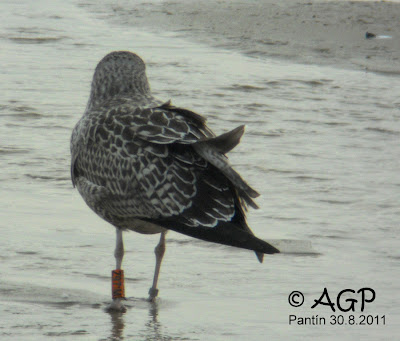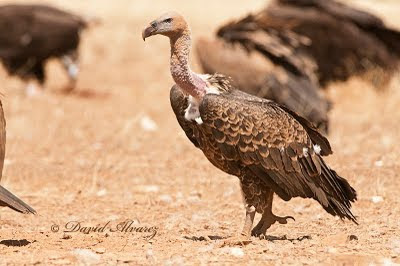 Tawny Pipit (Anthus campestris). Photo by Ángel M. Ceballos.A list of the most interesting records sent to the GOCE forum in July 2011. Compiled by Sergio Mayordomo.
Tawny Pipit (Anthus campestris). Photo by Ángel M. Ceballos.A list of the most interesting records sent to the GOCE forum in July 2011. Compiled by Sergio Mayordomo. -
Egyptian Goose: 4 adults and 12 young at Valdecañas Reservoir (Cáceres) on
28/07 (Ángel Sánchez and Ángel Luis Sánchez).
-
Shelduck: 2 adults and 12 young at Valdecañas Reservoir (Cáceres) on 28/07
(Á. Sánchez and Á. L. Sánchez).
-
Mandarin Duck: one female in the bathing channel of La Isla, Plasencia (Cáceres), on 17/07 (Javier Prieta).
-
Red-Crested Pochard: one female at Galisteo Lake (Cáceres) on 31/07 (S. Mayordomo).
-
Glossy Ibis: one lame bird still at Cerro Alto, Saucedilla (Cáceres) on 09/07 (Javier Briz and Manuel García del Rey). One bird at Valdecañas Reservoir (Cáceres) on 28/07 (Á. Sánchez and Á. L. Sánchez).
-
Spoonbill: over 70 at Los Canchales Reservoir (Badajoz) on 21/07 (Á. Sánchez). A flock of 30 at Charco Salado, Casatejada (Cáceres) on 21/07 (Eva Palacios and S. Mayordomo) and 40 on 26/07 (S. Mayordomo).
-
Squacco Heron: breeding proven at Orellana Reservoir (Badajoz: one pair with 2 chicks on 05/07 (Á. L. Sánchez, B. Cienfuegos, Domingo Rivera, P. J. García and P. Gasco). Fifteen birds including 8 young on ponds around Los Canchales Reservoir (Badajoz) on 21/07 (Á. Sánchez). One young bird at Charca de La Haba (Badajoz) on 30/07 (José Luis Pérez Chiscano and Juan Pablo Prieto). Eight birds on a pond of Montijo (Badajoz) on 30/07 (Á. Sánchez).
-
Purple Heron: one young bird at Portaje Reservoir (Cáceres) on 22/07 and 31/07
(S. Mayordomo). Four birds at Valdefuentes gravel pit, Galisteo (Cáceres) on 23/07 (César Clemente and Javier Mahíllo) and on 29/07 (S. Mayordomo).
-
Osprey: one bird at Los Canchales Reservoir (Badajoz) on 09/07 (A. Cangas and Elvira del Viejo). One bird at River Tiétar, Monfragüe (Cáceres), on 16/07 (María, park guard).
-
Marsh Harrier: new breeding site and first in the Alagón catchment area: one pair and one juvenile over Galisteo Lake (Cáceres) on 27/07 (S. Mayordomo).
-
Hobby: one bird at La Garganta (Cáceres) on 24/07 (Ricardo Montero).
-
Crane: one bird at Casas de Hitos (Badajoz) on 03/07 (Martin Kelsey). Two adults at Monroy (Cáceres) on 30/07 (Manu de Hauwae).
-
Purple Swamphen: breeding confirmed at Charco Salado, Casatejada (Cáceres): 2 adults and 2 large chicks seen on 26/07 (S. Mayordomo).
-
Avocet: one bird at Valdecañas Reservoir (Cáceres) on 28/07 (Á. Sánchez and Á. L. Sánchez).
-
Kentish Plover: 30 birds including 2 small chicks at Valdecañas Reservoir(Cáceres) on 28/07 (Á. Sánchez and Á. L. Sánchez).
-
Temminck's Stint: one bird at Portaje Reservoir(Cáceres) on 31/07 (S. Mayordomo).
- Lesser Black-Backed Gull: adult in breeding plumage at Valdesalor Reservoir (Cáceres) on 23/07 (S. Mayordomo) and several birds at Valdecañas Reservoir (Cáceres) on 28/07 (Á. Sánchez and Á. L. Sánchez).
 Mediterranean Gull (Larus melanocephalus). Two adults in the centre together with several Yellow-Legged Gulls of various ages and a Black-Headed Gull. Valdecañas Reservoir, 12.07.11 (Ángel Sánchez).
Mediterranean Gull (Larus melanocephalus). Two adults in the centre together with several Yellow-Legged Gulls of various ages and a Black-Headed Gull. Valdecañas Reservoir, 12.07.11 (Ángel Sánchez). -
Mediterranean Gull: 15 adults seen at Valdecañas Reservoir (Cáceres) on 12/07 (Á. Sánchez, J. A. Guerrero and Manuel Flores) and 2 on 28/07 (Á. Sánchez and Á. L. Sánchez). This is the biggest group ever recorded in Extremadura.
-
Common Tern: 5 birds at Valdecañas Reservoir (Cáceres) on 12/07 (Á. Sánchez, J. A. Guerrero and M. Flores).
-
Whiskered Tern: 2 birds at Portaje Reservoir(Cáceres) on 22/07 (S. Mayordomo).
-
Reed Warbler: one male singing at Valdefuentes gravel pit, Galisteo (Cáceres), on 03/07 (S. Mayordomo).
-
Western Olivaceous Warbler: 3 birds captured for ringing (one young and 2 adults) at River Guadiana, Badajoz capital, on 18/07 and 19/07 (Antón David Pérez). Could be Extremadura's second breeding record.
-
Pied Flycatcher: one male in breeding plumage at Cornalvo National Park(Badajoz) on 09/07 (José Ledo).
-
Tawny Pipit: one bird at Puerto de Esperabán, Pinofranqueado (Cáceres), on 24/07 (E. Palacios and S. Mayordomo).
FIRST POST-BREEDING DISPERSAL RECORDS -
Garganey: one female at Galisteo Lake (Cáceres) on 16/07 (Sergio Mayordomo) and 17/07 (J. Prieta). One drake at Valdefuentes gravel pit, Galisteo (Cáceres), on 17/07 (J. Prieta).
-
Shoveler: one female at Talaván Reservoir (Cáceres) on 16/07 and another at Charco Salado on 26/07 (S.Mayordomo).
-
Teal: one female at Galisteo (Cáceres) on 16/07 (S. Mayordomo) and 17/07 (J. Prieta). Four birds at Portaje Reservoir (Cáceres) on 22/07 (S. Mayordomo).
-
Ringed Plover: one bird at Valdesalor Reservoir(Cáceres) on 23/07, another at Talaván Reservoir(Cáceres) on 25/07 (S. Mayordomo) and another at Valdecañas Reservoir (Cáceres) on 28/07 (Á. Sánchez and Á. L. Sánchez).
-
Snipe: 4 birds at Galisteo Lake(Cáceres) on 27/07 and 1 bird at Portaje Reservoir (Cáceres) on 31/07 (S. Mayordomo).
-
Redshank: 2 birds on 23/07 at Valdesalor Reservoir (Cáceres) (S. Mayordomo) and 1 at Galisteo Lake(Cáceres) (C. Clemente and J. Mahíllo).
-
Spotted Redshank: 1 bird at Charco Salado, Casatejada (Cáceres), on 21/07 (E.
Palacios and S. Mayordomo) and 8 birds, 5 in breeding plumage, at the same site on 26/07 (S. Mayordomo). One bird in breeding plumage at Charca de La Haba (Badajoz) on 26/07 (J. L. Pérez Chiscano); still there on 30/07 (J. L. Pérez Chiscano and J. P. Prieto). One bird at Valdesalor Reservoir(Cáceres) on 30/07 (S. Mayordomo).
-
Wood Sandpiper: 1 bird at Sotillo Reservoir, Monroy (Cáceres), on 17/07 (S. Mayordomo) and another at Valdefuentes gravel pit, Galisteo (Cáceres), on 23/07
(C. Clemente and J. Mahíllo).
-
Ruff: 1 bird at Valdecañas Reservoir (Cáceres) on 28/07 (Á. Sánchez and Á. L. Sánchez).
-
Dunlin: 1 bird at Portaje Reservoir (Cáceres) on 22/07 and 2 at Valdesalor Reservoir (Cáceres) on 23/07 (S. Mayordomo).
-
Curlew Sandpiper: 15 birds at Valdecañas Reservoir (Cáceres) on 28/07 (Á. Sánchez and Á. L. Sánchez) and 2 at Valdesalor Reservoir(Cáceres) on 29/07 (S. Mayordomo).
-
Little Stint: several on a Mérida pond on 31/07 (Á. Sánchez).
-
Willow Warbler: 1 bird at Cornalvo (Badajoz) on 27/07 (Á. Sánchez, Isa and Jesús).
-
Iberian Chiffchaff: 1 bird at Galisteo (Cáceres) on 27/07 (S. Mayordomo).
-
Bonelli's Warbler: 2 birds at Cornalvo (Cáceres) on 09/07 and 10/07 (J. Ledo) and another 2 at Tentudía (Badajoz) on 14/07 (Alberto Pacheco).
-
Sedge Warbler: 2 birds la Valdefuentes gravel pit, Galisteo (Cáceres), on 29/07 (S.Mayordomo).
-
Whitethroat: 1 bird at Galisteo (Cáceres) on 31/07 (S. Mayordomo).
-
Wheatear: 1 bird at Cornalvo (Badajoz) on 27/07 (Á. Sánchez, Isa and Jesús).
-
Yellow Wagtail: at least 6 birds at Charco Salado, Casatejada (Cáceres), on 21/07 (E. Palacios and S. Mayordomo).
























































